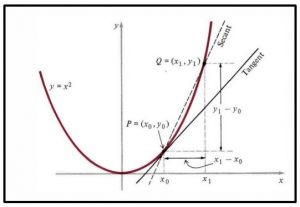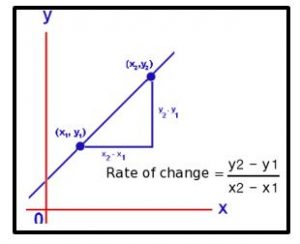Give the gift of life-changing education! Donate Now!
Discontinuity and Rate of Change
Points where f(x) fails to be continuous are called discontinuities of f(x) and f(x) is said to be discontinuous at these points. In a graph of a continuous function the pencil need never leave the paper, while for a discontinuous function this is not true since there is generally a jump taking place.
Slope of Tangent as Limit

Difference Quotient Applications
Example : f(x) = \({3x^3 -5x +4} \)
\(\frac{f(x+h) - f(x)}{h}\)=\( \frac{3(x+h)^2 - 5(x+h) +4 -(3x^2 - 5x + 4)}{h}\)
=\(\frac{3x^2 + 6xh + 3h^2 - 5x - 5h +4 - 3x^2 + 5x - 4}{h}\)
=\(\frac{6xh + 3h^2 - 5h}{h}\)
=\( 6x+3h -5 \)
Rates of Change

Limits of Functions
Limit of a composite function
If f(x) and g(x) are functions such that lim (x->c)g(x)= L and that
lim f(x)(x->L)= L, then
lim (x->c)f(g(x)) = f( lim (x->c)g(x))=f(L)
Continuity
3 conditions :
L’Hôpital ‘s rule
L’Hospital’s Rule says that if we have an indeterminate form \(\frac{0}{0}\) or \(\frac{\infty}{\infty}\)
Then , we must differentiate the numerator and differentiate the denominator and then take the limit.
lim(x->a)\(\frac{f(x)}{g(x)}\)= lim(x->a)\(\frac{f'(x)}{g'(x)}\)
Squeeze theorem
If g(x) ≤ f(x) ≤ h(x) for all x close to a, but not equal to a. If lim(x->a)g(x)= L and
lim(x->a)h(x)= L, then lim(x->a)f(x)= L
Special limits
lim(x->0)\(\frac{sinx}{x}\) = 1
lim(x->0) \(\frac{cosx -1}{x}\) = 1
lim(x->∞) \((1 +\frac{1}{x})^x\) = e
lim(x->0)\(({1+x})^{\frac{1}{x}}\) = e
lim(x->0)\(\frac{e^x - 1}{x}\) = 1
lim(x->0)\(\frac{x - 1}{ln x}\)